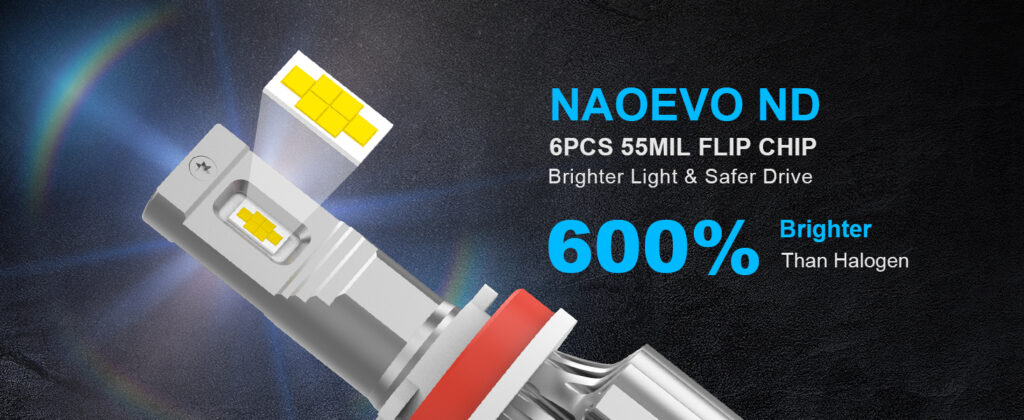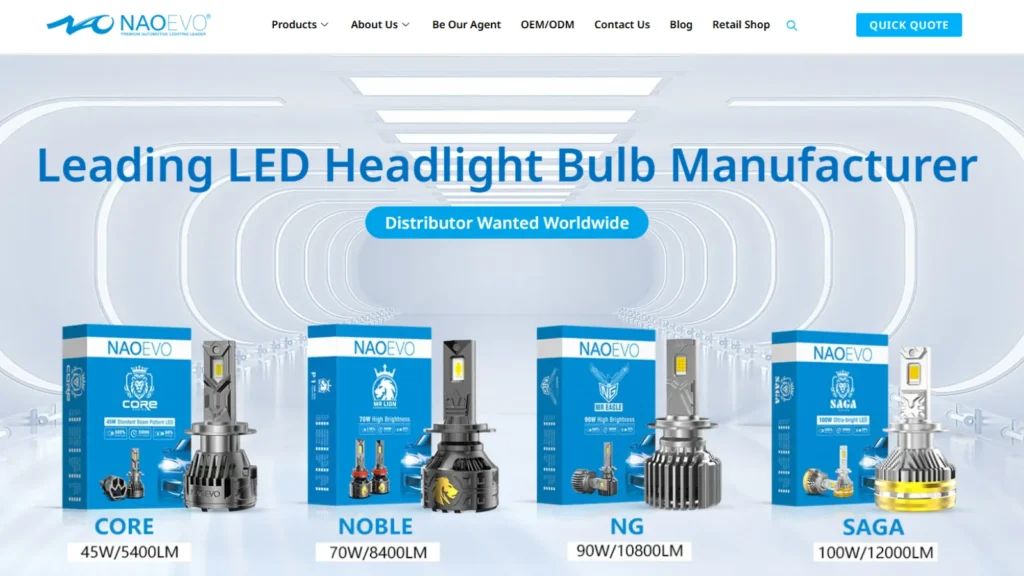Whether you are an end consumer or a wholesaler, if you plan to purchase automotive LED headlights, then this buying guide is a must-read.
Selecting the quality LED headlight bulb for your car used to be a straightforward thing, but the abundance of options available today can be overwhelming.
If you share this curiosity and are looking to upgrade your car headlights, you might be wondering how to identify a good LED headlight bulb without any regrets.
Deciding on a great LED headlight bulb can be a challenge, considering the wide range of options available in the market.
However, fear not! We are here to guide you through the process of discovering the 8 key features to look for in a high-quality LED headlight bulb. With our expert advice, you can confidently find the perfect LED headlight bulb that meets all your lighting needs.
1. Use High-Quality Chip
The LED chip is a core part of an LED headlight bulb and plays a vital role in determining its overall performance and quality.
LED chips are clarified as different brands, different packaging process and different sizes. At present, there are 5 kinds of chips commonly used in LED headlight bulb, which are CREE, Z ES, COB, CSP, FLIP-CHIP.
To learn more about their differences and features, check out: 5 Common Chips For Automotive LED Bulb, Which is The Best?
CREE | LUMILEDS Z ES | CSP | COB | FLIP CHIP |
|---|---|---|---|---|
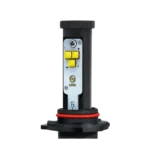 | 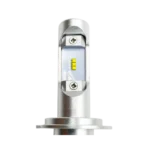 | 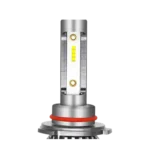 | 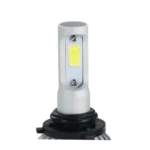 | 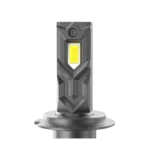 |
High Brightness
Big Angle
Wide exposure range | Longer lifespan
Excellent cutoff
Heat resistance | Compact design
Cheaper price | Enough brightness
Low price | Higher luminous flux
Stable quality
Perfect light beam
Cheaper price |
Expensive price
Poor light beam | Expensive price | Poor heat dissipation
Limited power | Potential overheating
Limited power
Poor light beam
Hard production process | Complexity in manufacturing |
Cree chips are known for high-quality and high brightness in the industry. Cree chips have square-shaped appearance along with silicone lens, this enable them to emit light at a wide angle, meanwhile, this also causes a glare light beam pattern. You can notice that their price is also higher than their counterparts.
Lumileds Z ES chips are a reputable LED technology known for high brightness and clear light beam pattern. but drawbacks may include higher cost compared to other options.
CSP LED headlight bulbs utilize chip-scale packaging, which allows for compact and densely arranged LED chips.
COB LED headlight bulbs integrate multiple LED chips directly onto a single substrate. This arrangement results in high luminous flux and excellent thermal management.
Flip chips take a good balance of price and quality. Many mid-to-high-end LED headlights use flip chips due to their high efficiency, high power, stable quality, long lifespan, and most importantly, they are reasonably priced compared to CREE and Lumileds Z ES.
From the above description, it is not difficult to find that choosing Flip-Chip LED car bulbs can significantly improve the illumination effect and reduce the cost of LED car lights.
2. Safe Light Beam Pattern
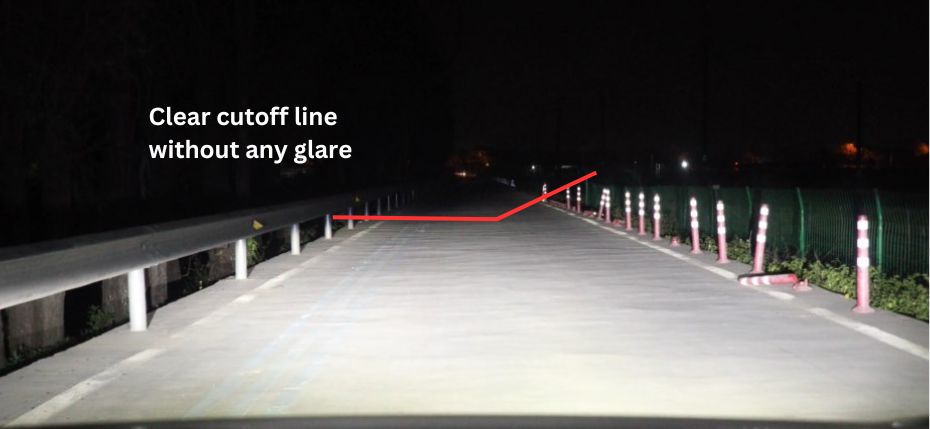

A high-quality LED headlight must have a safe light beam pattern to ensure it does not cause glare to oncoming vehicles.
Light beam pattern refers to the light angle and shape emitting through the headlight housing. Light beam patterns are as important as brightness and directly related to driving safety. To understand what makes a perfect light beam pattern of LED headlight bulb, it’s essential to evaluate how the LED mimics the original halogen bulb’s lighting position and focus.
Quality LED headlight bulbs emit a distinct 45 degrees cut-off line on low beams and focus light on high beams.
Low beams without any dark areas have two main benefits. On the one hand, they are helpful to see the oncoming traffic clearly without shining the eyes of other drivers.
On the other hand, perfect light beam patterns are contributed to a broader vision for drivers at night driving. They can see clearly on both sides of the road and react sooner to the accident.
In some right-hand driving countries, the light beam pattern should be lower on the left and higher on the right, and vice versa.
3. 1:1 Design As Halogen


A quality LED headlight bulb should maintain a 1:1 lighting filament with halogen. This ensures consistent light distribution prevents blinding glare, and requires minimal modification to your OEM reflector or projector headlight housing.
A great LED headlight bulb has a thin space between both sides of lamp beads so that they are close to the width of original filament as possible.
From the above two pictures you can see that the both sizes of lamp bead are too broad, and the LED chip is too wide, which can NOT simulate the filament size of halogen lamp.
If spaced too far apart, your beam pattern will lack focus, a hot spot, and might cause glare for other road users.
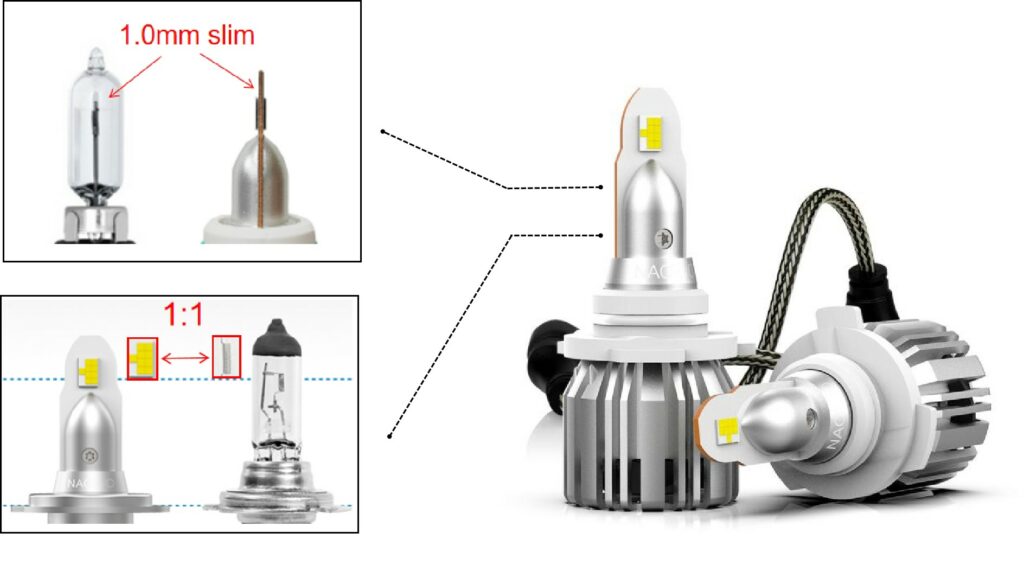
If you care about the road safety for yourself and others. It’s important to opt for a high-quality LED headlight bulb that mirrors the 1:1 design of your OEM bulb.
One great example is NAOEVO S3 LED bulbs, with only 1.18*2.76 Inch (30*70 mm) and ultra-slim 1.0mm space between two beads, they match the same size and emit same lighting position as halogen bulb.
4. Right Color Temperature
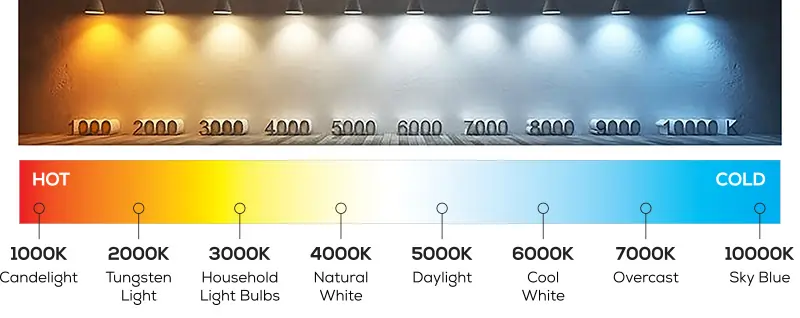

Individuals perceive colors uniquely, and varying color temperatures can alter how we view objects. Daytime’s natural light possesses a high color temperature, contributing to heightened brain activity and reduced eye strain.
If you are looking for a high-power LED bulb for your car, it is better to choose a color temperature in a range of 5000K to 6500K. This range is considered as “white” light with a slight bluish tint. It provides a balance between brightness, visibility, and reduced glare for both the driver and other road users.
You can explore more about the pros and cons of different color temperatures in this guide: 4300K vs. 5800K vs. 6500K, which is better?
If your area frequently experiences heavy rain, fog, or snow, it’s advisable to consider LED lights with a color temperature around 3000K-4300K. LED headlights of this color temperature usually emit yellow light, which has excellent penetration in extreme weather conditions. Whether it’s heavy rain or dense fog, drivers can have improved visibility at night.
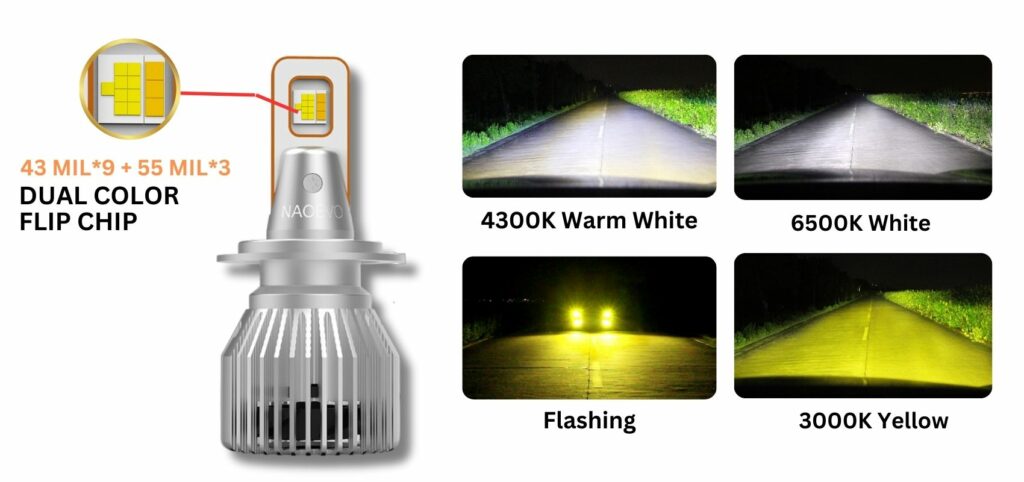
However, in some countries, rainy and foggy days are frequent. In this case, having LED car light bulbs perform well in all bad weather conditions is crucial for road safety. Check out the latest NAOEVO S4 LED headlight bulbs from NAOEVO. These bulbs integrated three colors and a flashing model. They are built to satisfy all your driving demands.
5. Effective Heat Dissipation
Good heat dissipation is a critical feature for quality LED headlight bulbs due to its impact on performance and longevity. LEDs generate heat while producing light, and effective heat dissipation prevents overheating, which can maintain stable brightness and prolong lifespan.
To understand this better, check out this in-depth guide: LED headlight bulb heat dissipation, everything you need to know.
There are four types of heat dissipation methods for LED headlights: 1. Aluminum Heat Sink 2. Fan Cooling 3. Copper Heat Pipe 4. Copper Belt
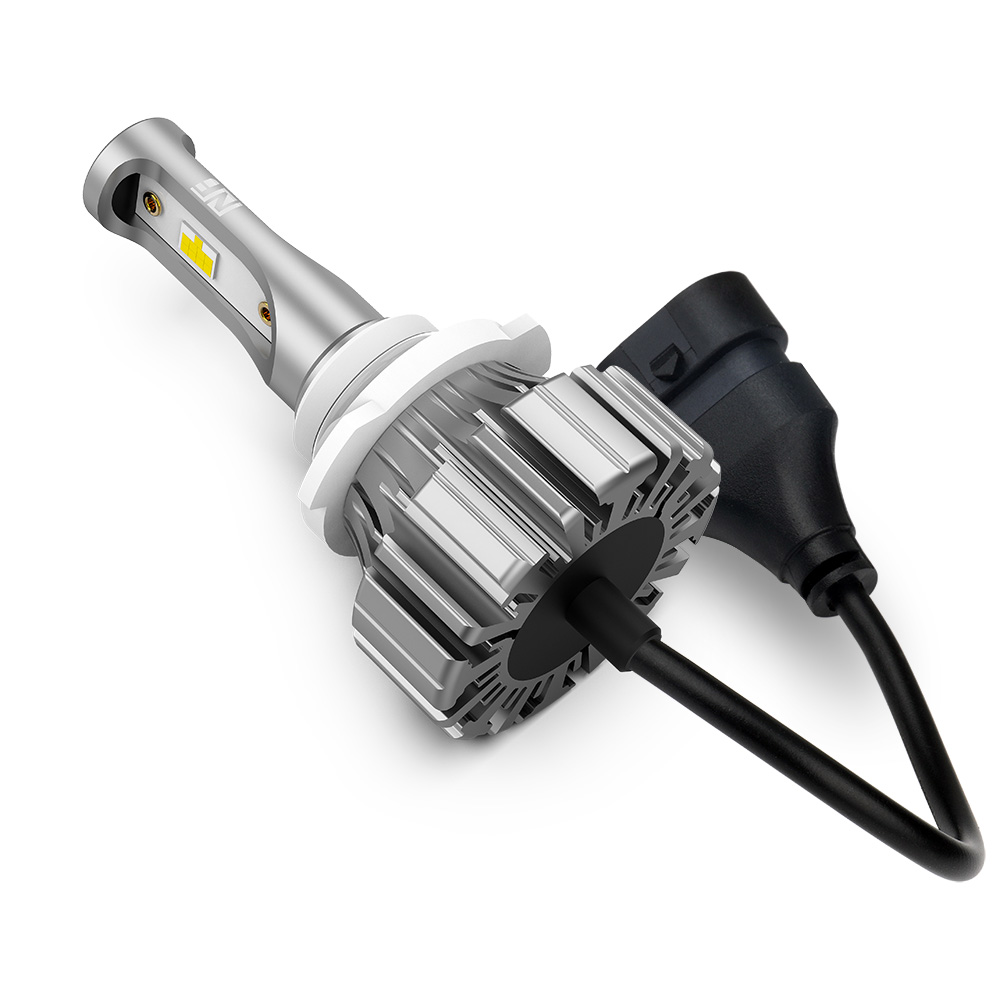
Fanless LED headlight bulbs rely on passive heat dissipation methods such as heat sink fins and aluminum lamp body.
The fanless design minimizes noise and potential mechanical failures, enhancing bulb reliability and lifespan.
However, due to no fan for active cooling, the power of fanless LED headlight bulb should be designed as low as possible.
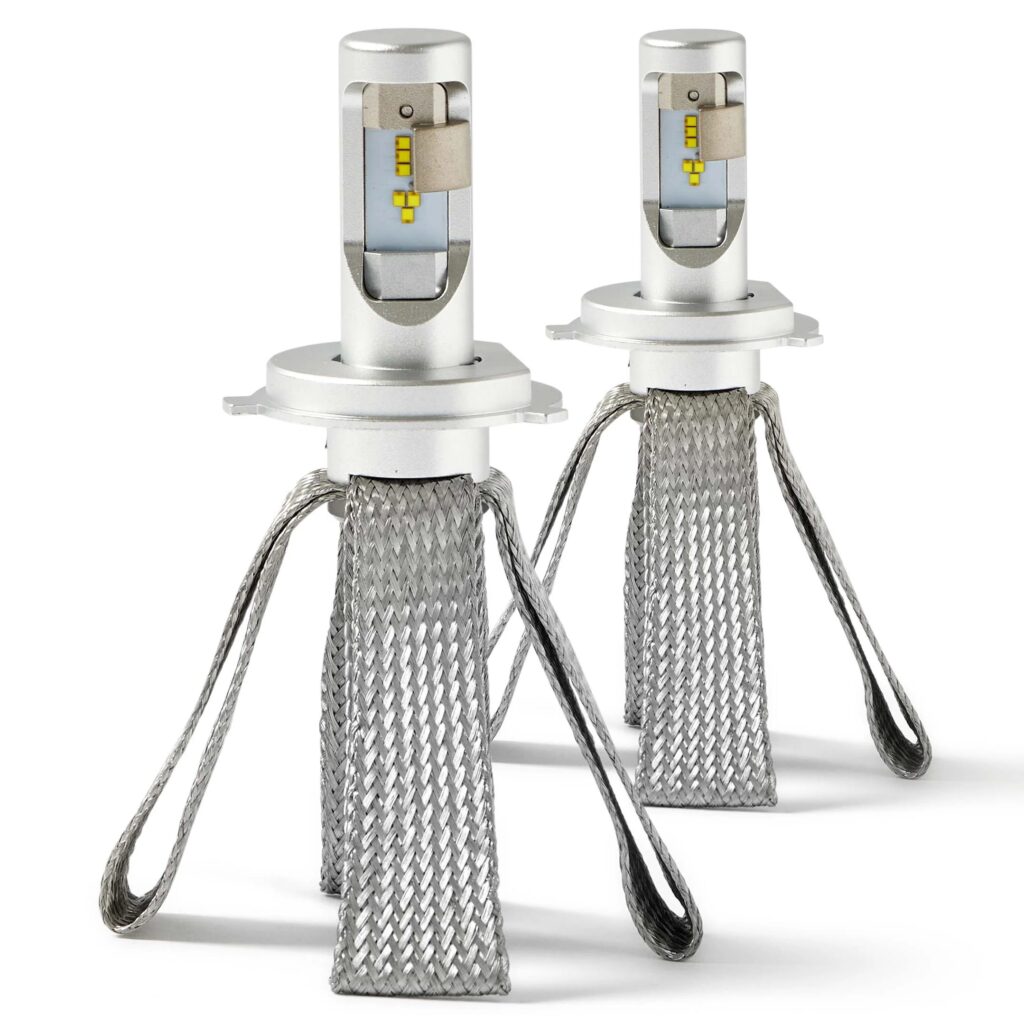
LED car light bulbs with copper belt heat sink are consist of copper wire coated with tin on the surface.
The copper tape fins and wings are adaptable to optimize the heat dissipation area.
It’s important not to excessively compress the wings together, as this could impair cooling performance.
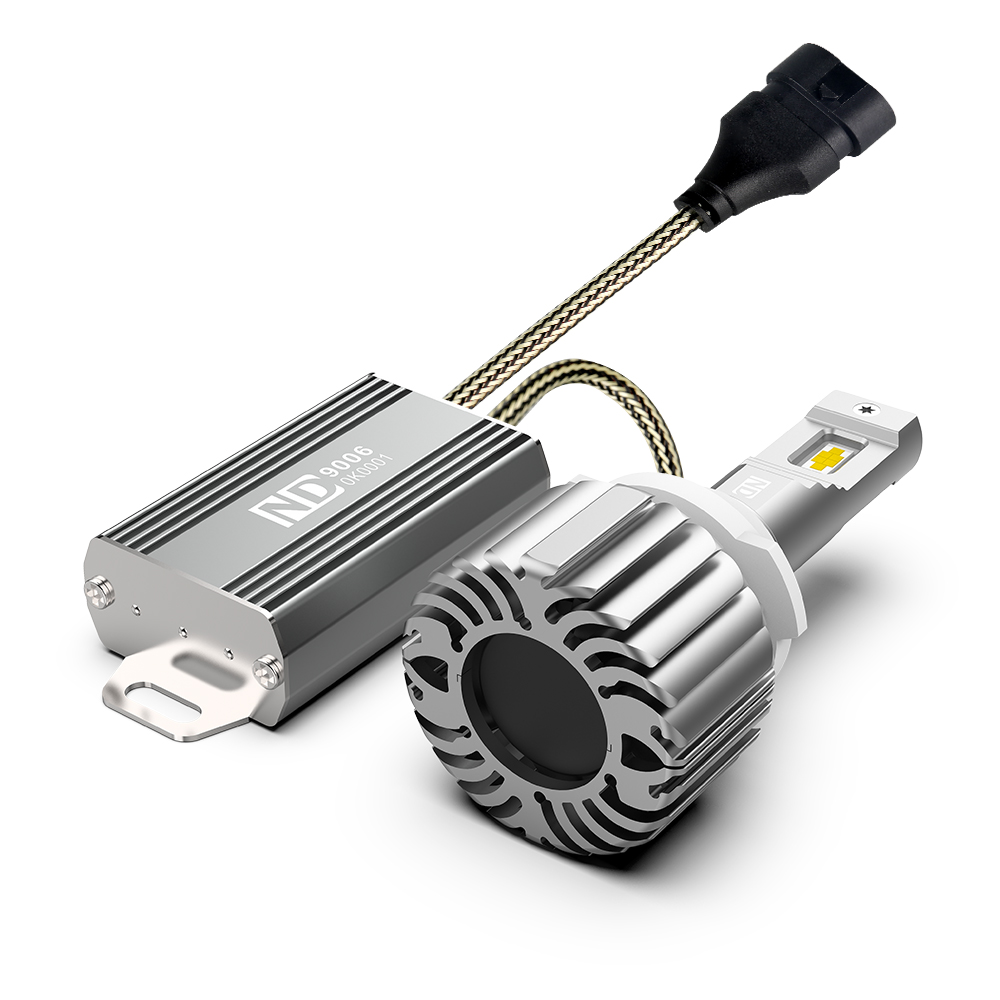
High-speed fans are a prevalent cooling solution among LED headlight bulb manufacturers.
These fans actively dissipate heat, ensuring the consistent functionality of high-power LED headlight bulbs.
Fan quality significantly impacts LED bulb lifespan; if the fan breakdown, the bulbs may become unusable as well.
Opt for LED headlight bulbs employing a combination of cooling methods such as copper heat pipe + fan to ensure efficient heat dissipation.This approach enhances bulb longevity, maintains consistent performance, and minimizes the risk of overheating-related issues.
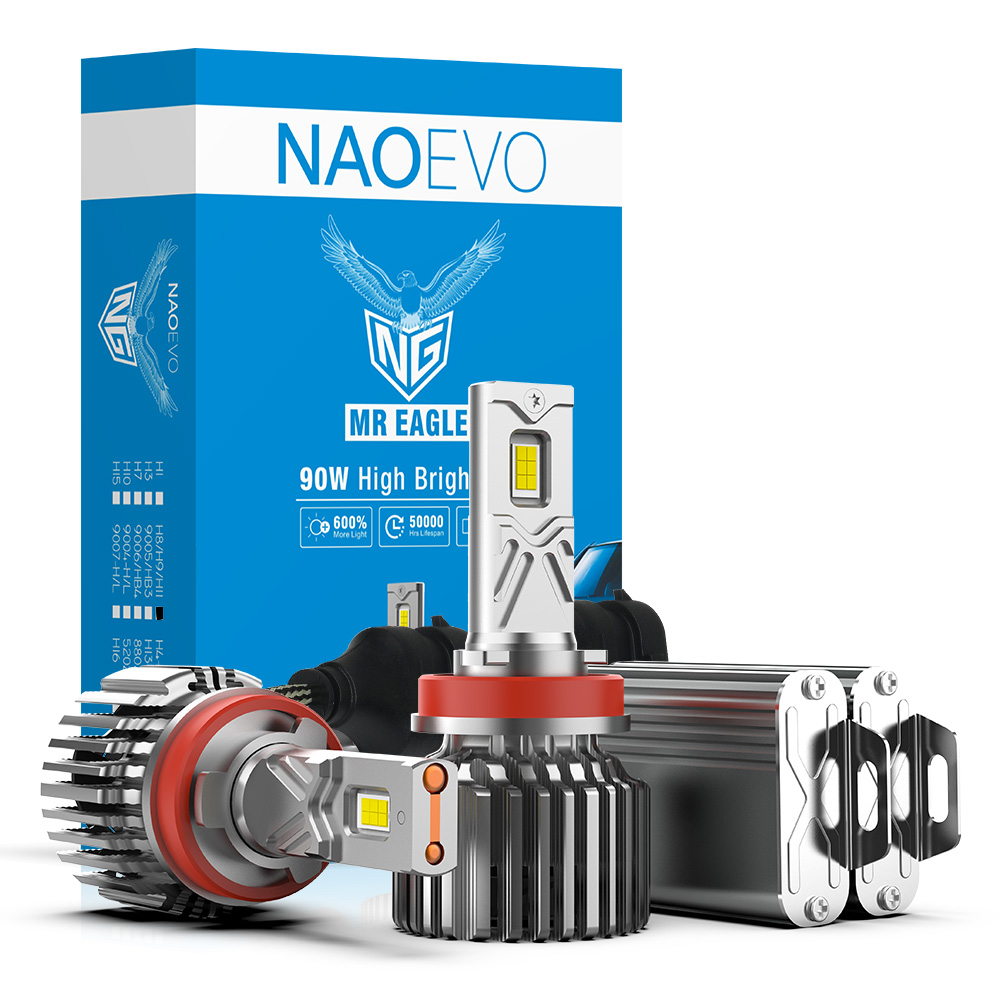
One good example is NAOEVO NG LED headlight bulbs, unlike others, they come with dual copper heat pipes and one of them have been upgraded to a bigger size of 51*4mm, so that they can transfer 30W of heat each time (while others can only transfer 10W or 20W).
Besides, the quality 6063 aluminum conduct the heat to the heat sink, and then with the help of high speed fan to speed up the flow of air.
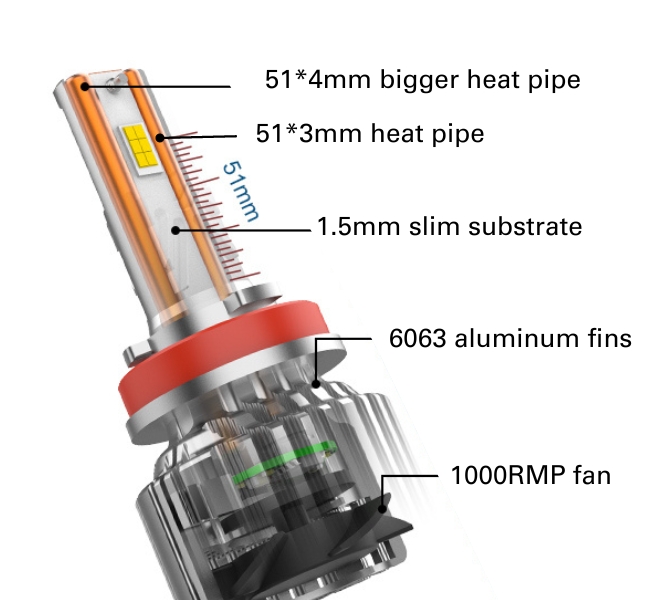
6. From a Well-Known Brand
There are numerous nameless LED headlight brands on the market. Most of these LED headlight bulbs are produced by some unregulated small workshops.
To save the cost, they will employ overclocked chip, resulting in short bursts of high lumens and rapid heat generation. Consequently, the headlight system quickly overheats and malfunctions. Despite claims of a 50,000-hour lifespan in their descriptions, the reality is that these bulbs can last for 1,000 hours or even less.


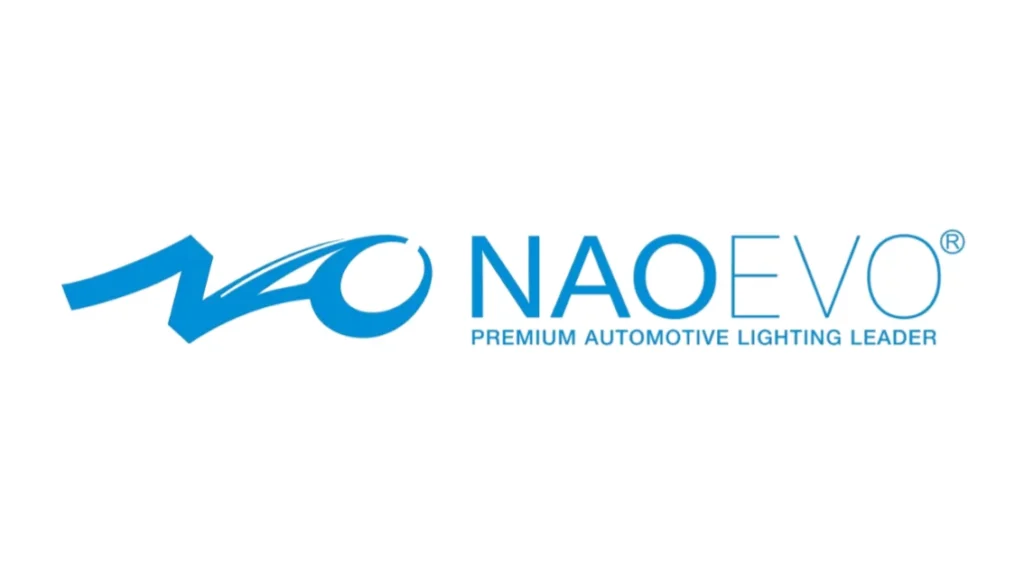
Thus, if want to choose quality LED headlight bulb, you should first to consider some reputable brands such as Osram, Philips, NAOEVO. These brands have rich experience in automotive lighting manufacturing, they have assurance in quality, performance, and durability.
Their products undergo rigorous testing, guaranteeing safety and longevity, and they will also provide necessary supports for their clients.
If you are looking for a reliable Chinese manufacturer for quality automotive LED lights. NAOEVO is the best choice for you!
As a one of the largest LED car light bulb leaders in China, they have in-house factory support and export 5 million sets of LED car lights each year.
By introducing lots of high-tech machines for manufacturing first-class LED light bulbs in various styles, their products are widely exported to the USA, Europe, Southeast Asia, and South America and have built more than 50 distributors around the world.
OTHER FACTORS
Bulb Model
Besides the above-mentioned tips, there’s one of the essential factors to think over when buying car headlights – whether the model fits the vehicle or not. In most cases, headlight bulbs are compatible with a wide range of models. The bulb models’ numbers are mainly divided into a single beam and dual beam functions.
You can check out your car bulb size model by looking at the user manual or searching the Car Bulb Finder tool for help.
The Legality of LED Bulbs
Every country has different laws that determine what makes the car bulb road legal. Consumers need to ensure that the headlights are permitted by law, road safety, and appropriate for traveling. There are also laws regarding the color of your headlights. Regardless of the region you live in, the law requires your headlight to be yellow or white. Some drivers may find that certain bulbs produce blue lights, which makes them non-road legal.
Upgrading with LED car light bulbs should also ensure that it carries RoHs, CE, and E-mark certifications, which comply with European standards. Or in the United States, it needs to be DOT-Compliant to follow US regulations.
IP Rating
The IP rating of a bulb determines the level of protection it has against dirt or water. The higher the IP rating level, the better the water resistance. The ratings most widely accepted as “waterproof” are IP65, IP67, and IP68. The difference between them is the degree of liquid ingress protection they offer.
IP65 Rating: Gives protection against low pressure as well as condensation.
IP67 Rating: Offer more substantial protection against liquid ingress, and protect against temporary submersion.
IP68 Rating: capable of continuous immersion in water.
Conclusion
We hope that the above factors can this article can help you to find the best and the most appropriate auto LED light bulb for your car.
FAQ
Lumens and lux. Lumens measure the amount of light output of LED bulbs. The higher the lumens, the brighter the light is. And luminous flux is the measure of the perceived power of light by the human eye. Besides, the brightness also depends on the wattage of the bulbs.
Canbus serves as a function to detect the faults in your car automatically. When you replace halogen with a LED bulb, the car may not be recognized immediately and signal message on the dashboard. It seems like sending an “error” message.
An error-free LED bulb means that the LED lamp is equipped with either resistor or
have an external decoder (Canbus driver) to mimic the power draw of the original
halogen bulbs to trick the computer into thinking that the bulbs are drawing the same rate as halogen, so that the vehicle won’t throw any error message.
Any brand of LED light bulb will do good as long as they are produced by a reliable manufacturer. Usually, we advise buying LED bulbs from some well-known brands such as Osram, Philips, or NAOEVO as they are the most trustworthy automotive lighting manufacturers.
The brightest LED headlight bulb on the market is – NAOEVO NG LED headlight kit. They usually provide 70W 8400LM per bulb, that is 180W 21,600LM per set. They produce not only high brightness but also have an outstanding balance of beam pattern and lifespan.
One bulb with two filaments produces either low beams or high beams. Such as H4, H13, 9004, and 9007 are all dual beam headlight bulbs.
Switching your halogen to LED headlights has many benefits. LED headlight bulbs are brighter and have a longer lifespan, better heat dissipation, and light efficiency than stock halogen bulbs.
Pros:
- Energy-Efficient
- Longer lifespan
- Better light beam pattern
- Better cooling system
- Money-saving


